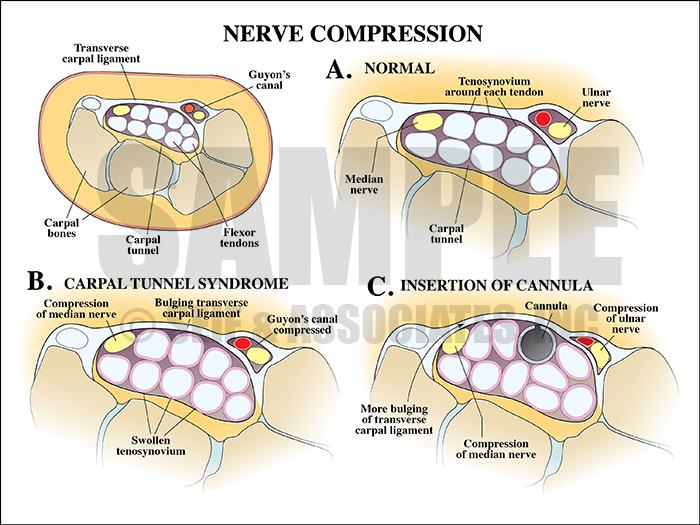This case involved a patient who underwent an endoscopic carpal tunnel surgery. During the procedure, the patient’s hand was dropped during transfer. Postoperatively he experienced transient neuropraxia. The defense in this case hinged on the jury’s ability to understand the anatomy of the carpal tunnel so that they could also understand how the neuropraxia could have occurred independent of the hand drop.
The plaintiff alleged that the neuropraxia was caused by the hand being dropped during transfer.
The defense’s next focus was to teach the jury about this endoscopic procedure. The first exhibit in this effort was aimed at walking the jury through the steps of the surgery anatomically, showing the placement of the instruments, how they are used to relieve the patient’s symptomatology, and also the relationships between the instruments and the relevant anatomy.
Exhibit 2A depicts the steps of carpal tunnel surgery.
Exhibit 2B continues to depict the steps of carpal tunnel surgery.
The next exhibit sought to give the jury a closer view of what this procedure looks like from an external perspective so that they could understand how the surgeon and assistant must manipulate the patient’s hand and wrist in order to perform this surgery.
Exhibit 3 depicts the steps of carpal tunnel surgery from an external perspective.
Then an exhibit was used to explain the sequence of events and incident that occurred during this procedure, as well as what was done after the incident. This allowed the jury to see that the defendant had turned away from the patient to obtain the hand holder device when the patient’s hand slipped. The PA then held the patient’s fingertips and palm to elevate them after the incident.
The defense used the next several visual exhibits to focus the jury’s attention on how the median nerve can become compressed within the carpal tunnel, showing that carpal tunnel syndrome itself causes nerve compression. These exhibits demonstrated how nerve compression can also occur with the insertion of the cannula, and ultimately how this nerve compression is relieved during surgery.
Exhibit 5 depicts nerve compression as a result of carpal tunnel syndrome.
Overlay used in trial depicting the carpal tunnel release.
Overall we designed the visual defense strategy in this case to fully educate the jury on the anatomy and steps involved in this procedure so that they could understand how this transient injury could have occurred in the absence of negligence on the defendant’s part. By introducing the jury to multiple views of the procedure as well as using simple diagrams to explain key points of the case, the defense was able to help the jury visually navigate the confusing anatomy and understand that although a mistake was made, it may not have been the cause of the negative outcome.
—Editorial contributed by Emily Ullo Steigler, MS, CMI
—Illustrations contributed by Robert Edwards, MS, CMI
















